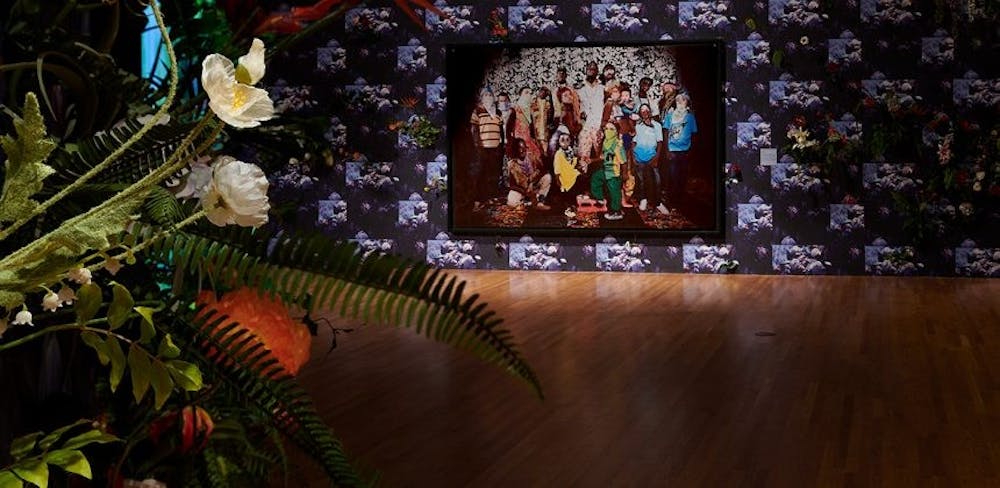The Nasher Museum of Art, like all other communities and initiatives at Duke, had to adapt during the pandemic. As Wendy Hower, the Director of Engagement & Marketing at the museum, said: “Everything has changed at the Nasher, and we spent the entire summer responding to COVID-19.”
The digital avenues that are now being explored come at a pivotal point in Duke’s history. We are witnessing an unprecedented transition in museum work, which is indicative of global trends.
There are two digital projects that have been developed over the course of the summer. The first is the digitization of “Ebony G. Patterson . . . while the dew is still on the roses . . .,” an exhibit created right before the closing of campus. When completed, it will bring Patterson’s breathtaking and provocative work to a wider audience.
The second exhibit, “Cultures of the Sea,” is ready for viewing on the Nasher website. Once you click to enter, you are placed in the middle of the physical space. Navigating virtually, in much the same way as Google Street View, the user can appreciate the bigger picture, or zoom into detailed 3D rotating images of the objects.
A delightful touch to the whole project is the presence of Memojis (animated characters that take on the appearance of the speaker) voiced by the curators of the exhibition, which go further in-depth about the exhibit. It is like a personal tour by the creators.
Julia McHugh, Ph.D., the Curator of Academic Initiatives at the Nasher and Adjunct Assistant Professor of Art History, was tasked with bringing in the people to collaborate on this unprecedented engagement for the museum.
“One of our big goals with the exhibition was to feature student work, so to really feature the way that students can be involved in the curatorial process and actually curate an exhibition at the Nasher,” she said. “One of the things we tried to do in the virtual tour was to give them a voice in some way. To be alive in the space. I think this is normally quite missing in other virtual content.”
The origin of this virtual exhibit lies in a time before COVID-19. Before the pandemic started, McHugh had already been working in the Wired! Lab with Mark Olson, and students such as Nathan Ostrowski ‘23, on a project called “The Art of the Americas Interactive.” This effort was focused on creating 3D models of exhibition works.
“With the pandemic, when everything shifted to a virtual realm, this project became even more important,” McHugh said. “It really transformed into creating a virtual space for this exhibition as quickly as possible. The neat thing is that there are 3D models embedded within the exhibition. So, it combines our past project with this current one.”
There were early collaborators in the digitization efforts. Duke Radiology helped the team do CT scans of artworks, and the Lemur Center provided guidance in thinking about the bone objects they were studying. “It really brought in all of these different partners across campus,” McHugh said. “This was all before COVID-19, so it is really fortuitous that we had started this work already.”
McHugh also noted the enthusiasm for digital projects that the new Director of the Nasher, Trevor Schoonmaker, has brought to the museum.
Ostrowski ‘23, who worked on the software development for the virtual exhibit, stresses the art history opportunities that are available to students interested in technology: “With museums, there is such a capacity for computer science students to create incredible works. The landscape of immersive museum tech changes every day, so I would encourage students to think deeply about the tools that would enhance their museum experience –– then go out and build them. The Nasher staff are embracing new ways of driving understanding and immersion, so if you have an idea, reach out and get involved!”
The heart of the “Cultures of the Sea” project is undeniably the students who curated it. Ally Perez ’20 took part in getting it from the classroom to the museum during her time as an intern in the Academic Initiatives department at the Nasher, and during the curatorial practicum course in Fall 2019. Perez noted, “Many of the objects had been in storage, untouched on their shelves for over 10 years. I wrote labels for objects in the show as well as worked on the exhibition text, which is the first introductory text you see when you walk into the show.”
She also added the point that all of the student curators for this exhibition were seniors. The digitization gives them the chance to say goodbye — something they were not afforded when campus shut down unexpectedly.
“The digital exhibition brings everything alive for me. I love hearing our voices. We worked so hard on this exhibition and for it to be available to anyone who would want to see it is incredibly special,” she said.
How is this individual project going to set the stage for future Nasher endeavors? According to Hower, this is just the beginning. “Every single exhibition going forward will be online. We have taken 360 photos of several other gallery spaces too. We would have never done that before the pandemic.”
Get The Chronicle straight to your inbox
Signup for our weekly newsletter. Cancel at any time.

